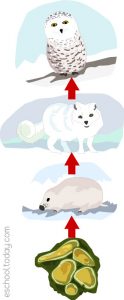- Ecosystems
An example of a food chain in The Tundra
The example below shows the energy flow in a basic food chain in The Tundra. This food chain is part of a more complex food web involving producers and consumers (herbivores, carnivores, and omnivores).
Producers here include grasses, lichens, and caribou moss. Herbivores that eat these plants include the musk ox, arctic hare, and lemmings. These herbivores are then eaten by carnivores such as arctic foxes and brown bears. Snowy owls, arctic wolves, and polar bears eat the carnivores. The top of this food pyramid is man, who hunts for these arctic wolves and bears for food and fur.
Now, look at the diagram below for an illustration of a food chain in the Tundra.

Omnivore
Snowy owls have smaller golden eyes claws covered with feathers. They are found mainly in the arctic open and treeless spaces. They usually perch on the ground and wait for yummy food (arctic fox, lemmings, and other birds and fish). Unlike other owls, they are more active in the day.
www.kids.nationalgeographic.com/content/kids/en_US/animals/snowy-owl/
Carnivore
The arctic fox (a mammal) has short ears, beautiful flurry coat that helps it to keep warm and also camouflage in the snow or ice. They make tunnels and burrows in the snow to create shelter.
www./animals.nationalgeographic.com/animals/mammals/arctic-fox/
Herbivore
Lemmings are small mouse-like animals. They have tiny claws that help them dig tunnels in the snow to sleep in. They are white during the winter, but their fur turns browny in the summer.
www.athropolis.com/arctic-facts/fact-lemming.htm
Producer
A lichen is a plant made up of fungus and a green alga. They grow almost anywhere, on rocky coasts, mountain summits, icy regions, tropical forests, and even on trees, rocks, and soils.
www.nhm.ac.uk/nature-online/life/plants-fungi/lichens/
